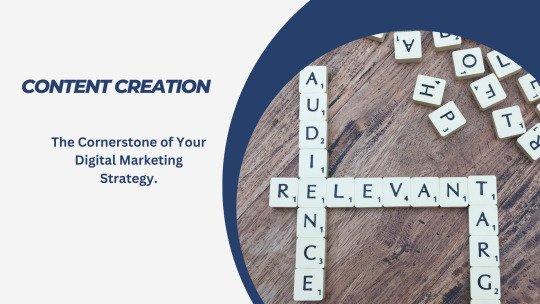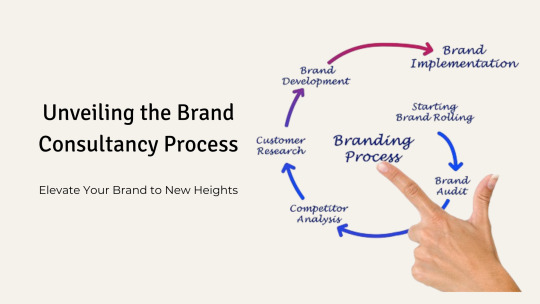Text
Unlocking the Power of Content Creation: A Guide to the Digital Marketing Process

In today's digital age, content is king. Whether you're a budding entrepreneur, a seasoned marketer, or simply someone looking to make their mark online, understanding the digital marketing process is essential. From crafting compelling blog posts to engaging social media updates, the world of content creation offers endless possibilities for reaching and connecting with your audience. So, let's delve into the fascinating realm of digital marketing and discover how content creation can elevate your brand to new heights.
1. Understanding Digital Marketing Process
Digital marketing encompasses a broad spectrum of activities aimed at promoting products or services through various online channels. It involves leveraging digital technologies to connect with potential customers and drive business growth.
2. Identifying Target Audience
Before diving into content creation, it's crucial to identify your target audience. Who are they? What are their interests and pain points? Understanding your audience enables you to tailor your content to resonate with their needs and preferences.
3. Keyword Research and Optimization
Keywords are the foundation of any successful digital marketing campaign. Conduct thorough keyword research to identify relevant terms and phrases your audience is searching for. Incorporate these keywords strategically into your content to improve visibility and rank higher in search engine results.
4. Crafting Compelling Content
Content is the heart of digital marketing. Whether it's blog posts, videos, or social media updates, compelling content captivates audiences and drives engagement. Focus on creating valuable, informative, and entertaining content that resonates with your target audience.
5. Leveraging Social Media Platforms
Social media platforms offer a powerful medium for connecting with your audience on a personal level. Choose the platforms where your audience is most active and tailor your content to suit each platform's unique features and audience demographics.
6. Email Marketing Strategies
Email marketing remains one of the most effective ways to nurture leads and drive conversions. Develop personalized email campaigns that provide value to your subscribers and encourage them to take action.
7. Search Engine Optimization (SEO) Techniques
Optimizing your content for search engines is essential for increasing visibility and driving organic traffic to your website. Focus on factors such as meta tags, headers, and quality backlinks to improve your site's search engine ranking.
8. Analyzing and Measuring Performance
Tracking and analyzing key performance metrics is essential for evaluating the success of your digital marketing efforts. Use tools like Google Analytics to monitor website traffic, conversion rates, and other relevant metrics.
9. Iterating and Improving Strategies
Digital marketing is an iterative process. Continuously monitor performance data, gather feedback, and refine your strategies to optimize results over time. Experimentation and adaptation are key to staying ahead in the ever-evolving digital landscape.
10. Conclusion
In conclusion, content creation is at the core of the digital marketing process. By understanding your audience, crafting compelling content, and leveraging various online channels, you can effectively promote your brand and achieve your business objectives in the digital realm.
Frequently Asked Questions
1. What role does content creation play in digital marketing?
Content creation is the backbone of digital marketing, serving as the primary means of engaging and communicating with target audiences across various online platforms.
2. How important is keyword optimization in content creation?
Keyword optimization is crucial for improving visibility and ranking higher in search engine results, thereby increasing organic traffic to your website.
3. What are some effective social media platforms for digital marketing?
Popular social media platforms like Facebook, Instagram, Twitter, LinkedIn, and TikTok offer diverse opportunities for connecting with audiences and promoting your brand.
4. How can I measure the success of my digital marketing efforts?
Key performance indicators (KPIs) such as website traffic, conversion rates, engagement metrics, and return on investment (ROI) can help gauge the effectiveness of your digital marketing strategies.
5. Why is continuous iteration and improvement essential in digital marketing?
The digital landscape is constantly evolving, and what works today may not work tomorrow. Continuous iteration and improvement allow marketers to adapt to changing trends and consumer preferences, ensuring long-term success.
#digital markating#socialmediamarketing#social media#social media manager#seo#ecommerce#web development#brandidentity#digital marketing plan
0 notes
Text
Establishing Brand Credibility

A Guide to Trust and Recognition
In today's fast-paced digital landscape, building brand credibility is essential for businesses aiming to stand out and succeed. But what exactly does it mean to have a credible brand? And how can you cultivate trust and recognition among your audience? In this comprehensive guide, we'll explore the importance of brand credibility and provide actionable strategies to help you establish and maintain it.
1. Understanding Brand Credibility
Brand credibility is the perception that consumers have about a brand's trustworthiness and reliability. It encompasses various factors, including the consistency of your messaging, the quality of your products or services, and how you interact with your audience.
2. Consistency is Key
Consistency breeds familiarity and trust. When your brand presents a cohesive image across all touchpoints, from your website to your social media channels to your packaging, it signals reliability to your audience. Consistent branding reinforces your identity and makes it easier for customers to recognize and remember you.
3. Delivering Quality Products
At the core of brand credibility lies the quality of your products or services. Consistently delivering high-quality offerings not only satisfies customers but also enhances your reputation. Strive to exceed expectations and address any issues promptly and transparently to maintain trust.
4. Engaging with Your Audience
Building a strong connection with your audience is crucial for establishing brand credibility. Actively engage with your customers through social media, email newsletters, and other channels. Listen to their feedback, address their concerns, and show genuine interest in their needs and preferences.
5. Transparency Builds Trust
Transparency is the cornerstone of trust. Be open and honest about your business practices, pricing, and policies. Transparency fosters authenticity, which resonates with consumers and strengthens their confidence in your brand.
6. Leveraging Social Proof
Social proof, such as customer reviews, testimonials, and endorsements, can significantly impact brand credibility. Showcase positive feedback from satisfied customers to validate the quality and value of your offerings. Encourage user-generated content and leverage influencer partnerships to amplify your brand's credibility.
7. Cultivating Thought Leadership
Positioning your brand as a thought leader in your industry can elevate your credibility and authority. Share valuable insights, industry trends, and expert opinions through content marketing, webinars, and speaking engagements. By providing valuable information and thought leadership, you demonstrate expertise and build trust with your audience.
8. Honesty in Communication
Honesty should be the foundation of your communication strategy. Avoid exaggeration or misleading claims, as they can undermine your credibility. Be transparent about your brand's strengths and weaknesses, and communicate openly with your audience to build trust over time.
9. Responding to Feedback
Feedback, whether positive or negative, provides valuable insights into your brand's performance. Monitor feedback channels closely and respond promptly and constructively. Addressing customer concerns demonstrates that you value their input and are committed to continuous improvement.
10. Going Above and Beyond
To truly differentiate your brand and solidify its credibility, go above and beyond in every interaction. Surprise and delight your customers with exceptional service, personalized experiences, and unexpected gestures of appreciation. By exceeding expectations, you'll leave a lasting impression and earn loyal advocates for your brand.
Conclusion:
In today's competitive marketplace, building brand credibility is non-negotiable. It's the foundation upon which trust, loyalty, and long-term success are built. By prioritizing consistency, quality, transparency, and engagement, you can establish a credible brand that resonates with your audience and stands the test of time.
Frequently Asked Questions
1. How long does it take to build brand credibility?
Building brand credibility is a continuous process that requires time, effort, and consistency. While there's no set timeline, focusing on delivering quality products/services and engaging authentically with your audience can expedite the process.
2. Can a small business establish brand credibility?
Absolutely! Regardless of size, businesses can build credibility by prioritizing customer satisfaction, maintaining transparency, and delivering value consistently. Leveraging social proof and cultivating a strong online presence are also effective strategies for small businesses.
3. Why is transparency important for brand credibility?
Transparency fosters trust and authenticity, which are essential components of brand credibility. When businesses are open and honest about their practices, policies, and pricing, they build stronger connections with their audience and differentiate themselves from competitors.
4. How can social proof enhance brand credibility?
Social proof, such as customer reviews, testimonials, and endorsements, provides tangible evidence of a brand's quality and reliability. By showcasing positive feedback from satisfied customers, businesses can validate their offerings and build trust with potential buyers.
5. What role does consistency play in brand credibility?
Consistency is paramount in building brand credibility as it reinforces your identity and signals reliability to your audience. By maintaining a cohesive brand image across all touchpoints and delivering a consistent experience, you establish trust and credibility with your customers.
#digital markating#seo services#markating#website#datadriven#data analysis#brandidentity#branding#brand credibility
0 notes
Text
A Path to Success in E-Commerce

Tracking Your Success in ROI
In the bustling world of e-commerce, success is often measured by one key metric: Return on Investment (ROI). But how do you ensure that your efforts are yielding the desired results? It all comes down to adopting the right mindset - the measurement mindset. In this article, we'll explore what it means to have a measurement mindset in e-commerce, why it's crucial for tracking success, and how you can implement it to optimize your ROI.
1. Understanding ROI
ROI is the holy grail of e-commerce success. It measures the profitability of an investment relative to its cost. Simply put, it tells you whether the effort and resources you've poured into your business are paying off.
2. Importance of Measurement Mindset
Having a measurement mindset means viewing every aspect of your e-commerce business through the lens of measurement and analysis. It's about being proactive in tracking your progress and making data-driven decisions.
3. Setting Clear Objectives
Before you can measure your success, you need to define what success looks like. Set clear, specific, and achievable goals for your e-commerce business, whether it's increasing sales, improving customer satisfaction, or expanding into new markets.
4. Choosing Relevant Metrics
Not all metrics are created equal. Focus on the key performance indicators (KPIs) that directly impact your bottom line. For e-commerce, this may include conversion rate, customer lifetime value, and average order value.
5. Tracking and Analyzing Data
Collecting data is only the first step. The real magic happens when you analyze that data to uncover insights and trends. Use tools like Google Analytics or e-commerce platforms' built-in analytics to track customer behavior and campaign performance.
6. Adjusting Strategies
The beauty of e-commerce is its flexibility. If something isn't working, don't be afraid to pivot. Whether it's tweaking your marketing campaigns, optimizing your website, or refining your product offerings, be willing to adapt based on the data.
7. Leveraging Technology
Technology is your best friend when it comes to measurement. Invest in tools and software that automate data collection and analysis, freeing up your time to focus on strategy and execution.
8. Continuous Learning and Improvement
The e-commerce landscape is constantly evolving. Stay ahead of the curve by staying informed about industry trends, attending conferences and webinars, and networking with other e-commerce professionals.
9. Celebrating Wins
Don't forget to celebrate your successes along the way. Whether it's reaching a sales milestone, improving your conversion rate, or launching a successful marketing campaign, take the time to acknowledge and appreciate your achievements.
Conclusion
In the fast-paced world of e-commerce, the measurement mindset is your secret weapon for success. By setting clear objectives, choosing relevant metrics, tracking and analyzing data, and continuously adapting your strategies, you can optimize your ROI and take your e-commerce business to new heights.
FAQs
1. What exactly is ROI in e-commerce? ROI, or Return on Investment, measures the profitability of an investment relative to its cost in the realm of e-commerce. It helps assess the effectiveness of your business efforts.
2. How can I develop a measurement mindset for my e-commerce business? Start by setting clear objectives, choosing relevant metrics, and regularly tracking and analyzing data. Embrace a culture of continuous learning and improvement.
3. What are some common metrics used to measure e-commerce success? Common metrics include conversion rate, customer lifetime value, average order value, and customer retention rate.
4. Why is it important to adjust strategies based on data analysis? Data analysis provides valuable insights into what's working and what's not. By adjusting your strategies accordingly, you can optimize performance and maximize ROI.
5. How can technology help with measurement in e-commerce? Technology offers a wide range of tools and software for data collection, analysis, and automation, making it easier than ever to track and optimize your e-commerce efforts.
#digital markating#seo services#website#markating#seo#ecommerce#dataanalytics#datadriven#businessintelligence
0 notes
Text
The Power of Data and Insights

In today's digital age, your website serves as more than just an online storefront. It's a powerful tool for gaining valuable insights into your customers' behavior, preferences, and needs. By harnessing the data and insights available through your website, you can better understand your audience and tailor your strategies to meet their expectations.
Why Data and Insights Matter
Your website is a treasure trove of valuable information about your customers. From the pages they visit to the actions they take, every click and interaction provides valuable data that can be analyzed to gain insights into their behavior. By understanding your customers better, you can make informed decisions that drive business growth and success.
Tracking Visitor Behavior
One of the key benefits of leveraging data from your website is the ability to track visitor behavior. By using tools like Google Analytics, you can see which pages are most popular, how long visitors spend on each page, and where they drop off. This insight allows you to identify areas for improvement and optimize your website for better user experience.
Analyzing User Engagement
Beyond just tracking page views, analyzing user engagement metrics such as bounce rate, time on page, and click-through rate can provide deeper insights into how visitors are interacting with your website. Are they finding the information they need quickly, or are they getting frustrated and leaving? Understanding these patterns can help you refine your content and design to keep visitors engaged.
Personalizing User Experience
With the abundance of data available, personalizing the user experience has become increasingly important. By segmenting your audience based on their behavior and preferences, you can deliver targeted content and offers that resonate with them on a personal level. This not only increases engagement but also fosters loyalty and trust.
Improving Conversion Rates
By analyzing data on user behavior throughout the conversion funnel, you can identify barriers to conversion and implement strategies to overcome them. Whether it's streamlining the checkout process or addressing common objections, optimizing your website based on insights can significantly improve your conversion rates and drive revenue growth.
Identifying Trends and Patterns
Another valuable aspect of leveraging data and insights is the ability to identify trends and patterns over time. By tracking changes in visitor behavior and market dynamics, you can stay ahead of the curve and adapt your strategies accordingly. This proactive approach ensures that your website remains relevant and competitive in a rapidly evolving landscape.
Enhancing Product Development
Your website can also serve as a valuable tool for product development. By gathering feedback from users, monitoring product page interactions, and analyzing purchase patterns, you can gain valuable insights into what your customers want and need. This feedback loop allows you to iterate on your products and services to better meet customer expectations.
Optimizing Marketing Campaigns
Data from your website can inform not only your website strategy but also your overall marketing efforts. By tracking the performance of different marketing channels, analyzing campaign metrics, and segmenting your audience, you can optimize your marketing campaigns for maximum effectiveness. This data-driven approach ensures that you're allocating resources wisely and reaching the right people with the right message.
Understanding Customer Needs
At the heart of it all, gaining valuable customer understanding through your website is about empathy. By putting yourself in your customers' shoes and understanding their needs, challenges, and motivations, you can create a website experience that truly resonates with them. This deep understanding fosters trust and loyalty, turning casual visitors into loyal advocates for your brand.
Building Long-term Relationships
Ultimately, the goal of leveraging data and insights from your website is to build long-term relationships with your customers. By continuously learning from their behavior and adapting your strategies accordingly, you can ensure that your website remains a valuable resource that they return to time and time again. This ongoing engagement fosters brand loyalty and advocacy, driving sustainable growth and success.
Conclusion
Your website is more than just a digital presence—it's a powerful tool for understanding and engaging with your customers on a deeper level. By harnessing the data and insights available to you, you can gain valuable understanding of your audience and tailor your strategies to meet their needs and expectations. From tracking visitor behavior to personalizing the user experience, the possibilities are endless when you leverage the power of data and insights.
FAQs
How can I track visitor behavior on my website?
You can track visitor behavior using tools like Google Analytics, which provide valuable insights into metrics such as page views, bounce rate, and time on page.
What are some common metrics used to analyze user engagement?
Common metrics used to analyze user engagement include bounce rate, time on page, and click-through rate, which provide insights into how visitors are interacting with your website.
How can personalizing the user experience benefit my website?
Personalizing the user experience can benefit your website by increasing engagement, fostering loyalty, and driving conversions through targeted content and offers.
Why is it important to identify trends and patterns in visitor behavior?
Identifying trends and patterns in visitor behavior allows you to stay ahead of the curve and adapt your strategies accordingly, ensuring that your website remains relevant and competitive.
What role does empathy play in understanding customer needs through my website?
Empathy is crucial in understanding customer needs through your website as it allows you to put yourself in your customers' shoes and create a website experience that truly resonates with them.
0 notes
Text
The Brand Development Process.

In today's fiercely competitive market, standing out from the crowd is essential for businesses aiming to thrive. Enter the realm of brand consultancy, a strategic process designed to sculpt and amplify your brand's identity, voice, and presence in the market. But what exactly does the brand consultancy process entail, and how can it benefit your business? Let's embark on a journey to unravel the intricacies of brand consultancy and discover how it can propel your brand towards unparalleled success.
1. Understanding Brand Consultancy
Brand consultancy is akin to hiring a seasoned guide to navigate the labyrinth of brand development and management. It involves a collaborative process between the consultancy firm and the client to enhance the brand's perception, relevance, and resonance with its target audience.
2. Assessing Your Brand's Landscape
Before embarking on any transformative journey, it's crucial to assess your starting point. Brand consultants delve deep into your brand's current positioning, strengths, weaknesses, opportunities, and threats (SWOT analysis). This comprehensive evaluation forms the foundation for strategic planning.
3. Defining Brand Identity
Your brand's identity is its unique fingerprint in the market. Consultants work closely with you to articulate your brand's core values, mission, vision, and personality. This identity serves as the guiding light for all brand-related activities.
4. Crafting Compelling Brand Messaging
Effective communication is the cornerstone of successful branding. Brand consultants help craft a compelling narrative that resonates with your target audience, conveying your brand's story, values, and offerings in a clear and engaging manner.
5. Audience Analysis and Targeting
Understanding your audience is paramount to crafting tailored brand experiences. Consultants conduct thorough audience research to identify demographics, preferences, pain points, and behavior patterns, enabling precise targeting and messaging.
6. Competitive Analysis
In a crowded marketplace, knowing your competitors is crucial. Consultants analyze competitor strategies, positioning, and messaging to identify whitespace opportunities and formulate strategies that set your brand apart.
7. Designing Brand Visuals
Visual elements play a pivotal role in brand perception. From logos to color schemes, consultants collaborate with designers to create visually striking assets that embody your brand's essence and resonate with your audience.
8. Implementing Brand Strategies
With a meticulously crafted strategy in hand, it's time to execute. Consultants guide you through the implementation process, ensuring seamless integration across all touchpoints, from marketing campaigns to customer interactions.
9. Monitoring and Adaptation
The brand landscape is ever-evolving, and adaptability is key to staying ahead. Consultants continuously monitor market trends, consumer sentiment, and brand performance, tweaking strategies as needed to maintain relevance and efficacy.
10. Measuring Success
Metrics matter. Consultants employ a range of key performance indicators (KPIs) to gauge the effectiveness of branding efforts, from brand awareness and engagement to customer loyalty and revenue growth.
Conclusion
In the dynamic arena of modern business, a strong brand is a powerful asset. Through the meticulous orchestration of the brand consultancy process, businesses can unlock their full potential, forging meaningful connections with their audience and carving out a distinctive space in the market.
Frequently Asked Questions (FAQs)
1. What is brand consultancy, and why is it important for businesses?
Brand consultancy is a strategic process aimed at enhancing a brand's identity, relevance, and resonance with its target audience. It's essential for businesses looking to differentiate themselves in a competitive market landscape.
2. How does brand consultancy differ from traditional marketing?
While traditional marketing focuses on promoting products or services, brand consultancy delves deeper into shaping the overall perception and positioning of a brand, encompassing its values, personality, and long-term strategic goals.
3. How long does the brand consultancy process typically take?
The duration of the brand consultancy process varies depending on the complexity of the project and the scope of work involved. It can range from several weeks to several months, with ongoing monitoring and adaptation.
4. What are some signs that a business may benefit from brand consultancy?
Businesses experiencing stagnating growth, inconsistent branding, lack of brand differentiation, or shifting market dynamics may benefit from engaging a brand consultancy firm to realign their brand strategy and rejuvenate their brand identity.
5. Can brand consultancy help small businesses and startups?
Absolutely. Brand consultancy is not exclusive to large corporations. Small businesses and startups can benefit immensely from strategic brand guidance, as it can help them establish a strong brand presence, build credibility, and foster customer loyalty from the outset.
#digital markating#brand strategy#Brand consultancy#brand development#best digital marketing company
0 notes
Text
The Power of Digital Marketing
Your Ultimate Guide

In today's fast-paced digital world, digital marketing has become an essential tool for businesses to reach and engage their target audience effectively. But what exactly is digital marketing, and how can it benefit you? Let's dive in and explore the world of digital marketing together.
Table of Contents
Understanding Digital Marketing
2. Types of Digital Marketing Channels
3. The Importance of Content Marketing
4 .Leveraging Social Media Platforms
5. Search Engine Optimization (SEO)
6. Pay-Per-Click (PPC) Advertising
7. Email Marketing: Direct to Your Inbox
8. The Influence of Influencer Marketing
9. Data-Driven Decision Making
10. Measuring Success: Analytics and KPIs
11. Crafting a Digital Marketing Strategy
12. The Future of Digital Marketing
Understanding Digital Marketing
Digital marketing encompasses all marketing efforts that utilize electronic devices or the internet. Unlike traditional marketing, which relies on physical mediums like print or television, digital marketing leverages online channels to connect with potential customers in real-time.
Types of Digital Marketing Channels
Social Media Marketing
Social media platforms like Facebook, Instagram, Twitter, and LinkedIn offer unparalleled opportunities for businesses to engage with their audience on a personal level. By creating compelling content and interacting with followers, brands can build a loyal following and increase brand awareness.
Content Marketing
Content is king in the digital marketing world. Whether it's blog posts, videos, or infographics, valuable content helps attract and retain customers. By providing relevant and informative content, businesses can position themselves as industry leaders and establish trust with their audience.
Search Engine Optimization (SEO)
SEO is the process of optimizing your website to rank higher in search engine results pages (SERPs). By targeting specific keywords and improving your website's structure and content, you can increase organic traffic and drive more qualified leads to your site.
Pay-Per-Click (PPC) Advertising
PPC advertising allows businesses to bid on keywords and display ads on search engine results pages and other online platforms. With PPC, you only pay when a user clicks on your ad, making it a cost-effective way to drive targeted traffic to your website.
Email Marketing
Email marketing remains one of the most effective digital marketing channels for reaching and engaging customers. By sending personalized, relevant content directly to their inbox, businesses can nurture leads, drive conversions, and increase customer retention.
Influencer Marketing
Influencer marketing involves partnering with influential individuals on social media to promote your products or services. By leveraging the trust and authority of influencers, brands can reach new audiences and generate authentic engagement.
Data-Driven Decision Making
In the digital age, data is king. By analyzing customer behavior and campaign performance, businesses can make informed decisions and optimize their marketing strategies for maximum impact.
Measuring Success: Analytics and KPIs
Tracking key performance indicators (KPIs) and analyzing marketing analytics is essential for measuring the success of your digital marketing efforts. Whether it's website traffic, conversion rates, or social media engagement, data-driven insights help identify areas for improvement and guide future strategies.
Crafting a Digital Marketing Strategy
A successful digital marketing strategy requires careful planning and execution. By setting clear goals, identifying your target audience, and selecting the right mix of digital marketing channels, you can create a cohesive strategy that drives results.
The Future of Digital Marketing
As technology continues to evolve, so too will the world of digital marketing. From artificial intelligence and machine learning to augmented reality and voice search, the future holds endless possibilities for businesses looking to stay ahead of the curve.
FAQs (Frequently Asked Questions)
Q1. What is digital marketing, and why is it important?
Digital marketing refers to marketing efforts that utilize electronic devices or the internet to reach and engage with potential customers. It's essential because it allows businesses to connect with their target audience in real-time, increase brand awareness, and drive sales.
Q2. How can I measure the success of my digital marketing campaigns?
You can measure the success of your digital marketing campaigns by tracking key performance indicators (KPIs) such as website traffic, conversion rates, and social media engagement. Analyzing these metrics will help you identify areas for improvement and optimize your strategies for better results.
Q3. What are some common digital marketing channels?
Some common digital marketing channels include social media marketing, content marketing, search engine optimization (SEO), pay-per-click (PPC) advertising, email marketing, and influencer marketing.
Q4. How can I get started with digital marketing for my business?
To get started with digital marketing for your business, it's essential to define your goals, identify your target audience, and select the right mix of digital marketing channels. You can then create a cohesive strategy and begin executing your campaigns.
Q5. What trends can we expect to see in the future of digital marketing?
The future of digital marketing holds endless possibilities, with trends such as artificial intelligence, machine learning, augmented reality, and voice search expected to play a significant role. Businesses that embrace these technologies will have a competitive edge in the digital landscape.
Digital marketing is not just a trend; it's a fundamental shift in how businesses connect with their audience. By leveraging the power of digital marketing channels, you can reach new customers, build brand loyalty, and drive business growth in the digital age.
#digital markating#seo#seo services#digital marketing agency#digital marketing expert#social media marketing#social media
1 note
·
View note